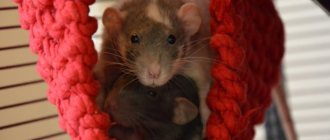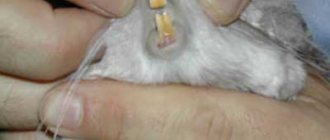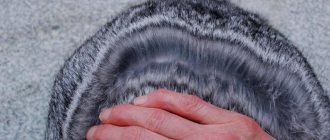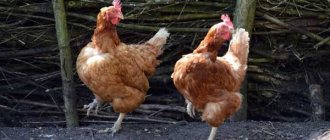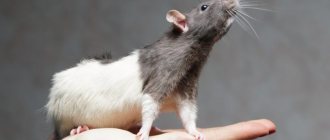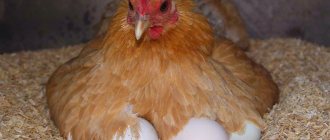Breeding chinchillas at home is not difficult, but it requires constant attention. It is important to know the basic rules that will help you from selecting a male or female to helping the cubs and the female after giving birth. Chinchillas are not monogamous animals; a male can mate with several females.
In this article you will find instructions, tips, videos and photos to help you mate chinchillas.
I hope that you will only breed chinchillas for sale and will not create a farm where they are killed for their fur.
Species diversity
There are quite a few breeds of chinchillas and a variety of colors. To breed chinchillas at home, you need to choose only valuable colors, which cost from 8,000 rubles per child.
To choose the right male, you need to know the name of your breed. The male's coloration should roughly match the male's to ensure you get the right coloration in the cubs.
The main breeds of chinchillas:
- Albino;
- White recessive;
- White dominant;
- Pink and white;
- Beige dominant;
- Agouti;
- Foggy;
- Motley, etc.
To know which species can be crossed and which cannot, look at the genetic table.
Features of choosing and purchasing breeding stock
Once you have prepared the room and cage, it is time to start purchasing livestock. For a home mini-farm, it is enough to purchase 2 males and 10 females. Such a set can produce 70-80 young animals in 1 year.
Many breeders and farms provide temporary males for mating - consider these options.
There is an opinion that chinchillas should be bred monogamously, i.e. form pairs and let them breed separately. This method has a number of advantages, but is more expensive.
Buy young animals only from large and trusted breeders. This way you will protect yourself from buying a sick animal. In addition, breeders can provide a guarantee and a breeding card.
Sexual maturity
The female is ready to mate at the age of 8 months, and the male is already at 6-7. A chinchilla at this age should already weigh more than 500 grams; if she has not gained that weight, then she is not yet ready for mating, because it will be difficult for her to bear offspring.
On average, chinchillas continue to give birth until they are 10-12 years old. A female can bring up to 2-3 offspring per year, and the number of cubs will always be different, from 1 to 5. There is no need to continuously mate animals, otherwise the female will age faster and lose her health.
Sales of products
In this type of business, there are 4 main methods for selling products:
- Sale of live culled pets - at first, when work is underway to create a herd, individuals should be culled in order to achieve purity of the breed. Pet stores will be happy to purchase such chinchillas; you can also sell them at poultry markets or place an ad in newspapers, magazines and online.
- Sale of live breeding animals - after the herd has been formed, it is fashionable to sell animals for breeding work. The purchase of such individuals may be of interest to identical farms engaged in breeding chinchillas.
- Fur coat - when production volumes increase, animal skins can be sold. Various ateliers and factories for the production of fur products will buy such products.
- Sales at auctions . In foreign countries, auctions are held at which fur is purchased, but this is possible if the production volume increases to 5 thousand skins per year.
What you need to know to breed chinchillas
You should choose only strong and healthy chinchillas; only they will be able to produce good offspring for a long time. The second factor is beauty, it is important to take cute animals that people will buy with great desire. Beautiful parents will have beautiful babies.
Choose chinchillas with a thick and long coat, because their beautiful fur is why they are valued.
Cubs are born with their eyes open and they can see everything. They also have teeth and hair. A few days after birth, they are already able to feed themselves, but in order for them to grow properly they must be fed from their mother for 70 days. When the due date comes and the cubs have reached a weight of 200-300 grams, they can be placed in another cage and fed on their own. Until chinchillas are 100 days old, it is better not to give them to new owners; first you need to make sure that you separated them from their mother on time and that the animal does not have any diseases.
CHINCHILLA REPRODUCTION AND CARE OF THE YOUNGDo not forget that it is unacceptable to mate chinchillas from the same family. This will lead to unhealthy offspring.
Reproduction of chinchillas is not such a labor-intensive process; Most chinchilla breeders successfully cope with this task. In order to increase fertility and reduce the impact of negative phenomena, it is necessary to better understand the biology of their reproduction and the main conditions of care. Compared to other rodents, they have a longer gestation period associated with slow fetal development, as a result of which the female cannot give birth more than 3 times a year.
The seasonality of births, determined and obvious by the climate of their natural habitat, was also studied. The best time of year for the appearance of offspring there was the end of summer - autumn, which in our case corresponds to December - May. From the very beginning of chinchilla breeding in captivity, there was an increase in activity in the first half of the year; mainly during this period, females became pregnant and gave birth twice in a row. In the second half, the barren period began, when the females avoided mating and regained their strength. From studies of North American chinchilla breeders it follows that after lambing in July–August, only about twenty percent of the females were covered. In Japan, chinchillas breed between March and August. During the period of highest activity, this cycle lasts 29–36 days, later it gradually lengthens to 30–55 days, and in the second half of the year, with the lowest sexual activity, as much as 70–90, even up to 150 days. If chinchillas are provided with conditions of constant temperature and daylight hours, they gradually lose this seasonality and give birth all year round. This phenomenon allows fur farmers to use animals more intensively.
An equally useful phenomenon, the regularity of lambing, is the polyesterity of females, as well as the so-called postpartum estrus, which makes it possible to cover them literally the next day after giving birth.
Specifics of chinchilla reproduction
Females reach sexual maturity by 4 months, but on farms they are allowed to mate for the first time at 6–9 months. Females retain the ability to reproduce for quite a long time, up to 9-15 years, but they are not kept on farms for that long, mainly because their fertility decreases with age. Chinchillas are polyestrous animals, i.e. the sexual cycle is repeated several times a year. In most cases, the cycle length is stable and equal to 38 days. Taking this circumstance into account makes it possible to achieve uniform and more intensive reproduction of animals.
The performance of chinchillas depends on the intensity of their use. Theoretically, you can get three litters per year from each female. However, it turns out that in this case they quickly lose their birthing abilities. On the other hand, an unjustified increase in the periods between lambs is disadvantageous for the owner. The best solution is to obtain an average of two lambings per year. Three-time births cause excessive fatigue (exhaustion) of females, which subsequently leads to the need for longer breaks. The productivity of females decreases after the 20th lambing. This means that the best results are obtained when females on farms live for about 7-12 years.
The course of the sexual cycle
Each sexual cycle in a female consists of 4 phases: before estrus (proestrus), estrus (estrus), after estrus (metaestrus) and between estrus (diestrus). Each of them causes specific changes in the female reproductive system associated with the intensity of egg formation or the course of pregnancy; these changes are regulated by hormones produced by the ovaries and other organs. Estrogens produced by the ovarian vesicles are directly responsible for the onset of estrus. They cause changes in the organs and behavior of the female characteristic of estrus. Increased levels of estrogen in the blood stimulate the activation of organs that produce hormones responsible for ovulation. Chinchillas ovulate spontaneously. Instead of ovarian vesicles, yellow bodies appear that produce progesterone, which stimulates the implantation of embryos into the uterine wall and the progress of pregnancy. If pregnancy does not occur, the activity of the yellow body gradually decreases, and then it disappears (luteolysis); a decrease in the amount of progesterone in the blood is a stimulus for the appendage to again begin secreting hormones that stimulate the production of estrogen and the beginning of a new sexual cycle.
Childbirth outcomes depend on both hormone production and a variety of other internal and external factors. Some genetic factors (embryonic mortality, congenital defects), as well as environmental factors (food quality, age of the female, illness, stress), influencing the hormonal composition, can cause a decrease in the female’s birth potential.
The estrus phase lasts from 12 hours to 4 days and is accompanied by extensive redness and swelling of the external genitalia, opening of the vagina (usually closed), a specific behavioral reflex towards the male, as well as changes in the vaginal microflora. In a cytological examination of a smear, red cells predominate in this phase of the cycle. A color change to orange-red indicates the end of estrus.
Covering
During estrus, which is accompanied, in particular, by the opening of the vagina, the female can be covered by the male several times. As a rule, copulations occur at night and last a very short time, making them difficult to observe.
Choosing a content system
Monogamous content. It involves keeping animals in pairs throughout the entire breeding season. This system was recently used everywhere, but now, for reasons of economics and ease of maintenance, it is recommended only for certain cases. However, it is important to note that in natural conditions, chinchillas lived in permanent pairs; monogamy was a natural way for them to organize a herd. Chinchillas kept in pairs are more active; the constancy of the partner protects the family from the stresses common in polygamy. Such stress, in particular, is the boredom of being alone in a cage, which often leads to the habit of self-gnawing of hair. In a monogamous system, not only the female, but also the father takes care of the puppies, which seems very important in the first days of life. Another advantage is that. That a male, even with low testicular productivity, is nevertheless quite suitable for procreation, since he only harbors one female. That is why such a system can be recommended to people who keep animals just for pleasure, as a hobby in their own home, as well as to experienced farmers for testing young males before selling them or including them in the main herd.
Polygamous family. This is a more modern form of keeping chinchillas; large farms simply cannot do without it. Males for polygamous families are selected on the basis of strict selection, which ensures the largest offspring and also improves the quality of the skins. Since fewer males are used with this method, the culled individuals increase the amount of final material produced. If we talk about the stressful situations that supporters of the monogamous system refer to, it turns out that they generally do not occur so often. A good male, if he has access to the cage, will definitely visit his newborn offspring from several litters. In addition, when using polygamy, less feed is required and the labor of staff is made easier.
Thus, it turns out that both described methods have their advantages and should be chosen depending on the size and purpose of breeding the animals. If, for example, you plan to keep 5-10 females. Monogamy is the best. It is better for the farmer to care for 10 pairs and ensure that there is no inbreeding. If instead he creates 2 families of 5 females each, he will soon be forced to buy additional animals to avoid marriages between close relatives. So we can confidently say that the polygamous method should be used when there are 5 or more families of chinchillas.
We must also remember that not every male is good for a polygamous family. Some of them, even in good condition, prefer to deal with only one female, showing aggression towards the rest. There are also those who, when put into a polygamous cage, get extremely stressed, do not approach the females at all, and if they do not have some kind of personal cage for themselves, they become completely unsuitable for the farm.
The course of pregnancy and childbirth
Pregnancy in chinchillas lasts an average of 111 days (range 105 to 112). This relatively long period is associated with the slow development of the fetus, especially in the early stage.
The ovaries of a mature female contain about 16 ovarian vesicles, of which 4 mature during the estrus phase; There is a theoretical possibility of getting 6-8 puppies in one litter, i.e. 12 puppies in two litters during the year. In practice, on farms it is occasionally possible to get 6–8 puppies from one female, and the female herself is not able to feed and raise so many young animals. The birth of 2 puppies should be considered a good result. On Russian farms, the usual increase is from 1.6 to 2.5 pieces, which is a consequence of 30% mortality of embryos due to the accumulation of lethal genes and intra- and extrauterine factors.
Lambing in chinchillas, despite their predominantly nocturnal lifestyle, most often occurs in the morning, between 6 and 9 o'clock. The approach of childbirth can be recognized by a change in the appearance of the nipples, blueness of the vaginal opening and its opening. Labor usually does not last long, from a few minutes to 2-3 hours, and begins with the discharge of a clear yellowish fluid from the vagina. Then the puppies are born and, finally, the placenta, which looks like a dark red mass with a diameter of 2-3 cm. The female then eats the placenta. Most females have a pronounced maternal instinct and immediately begin to care for the newborn. During and after birth, it is recommended to keep the female on a bedding that prevents injury to the mother and puppies and prevents them from freezing.
Caring for suckers
Chinchillas are born fully developed, with hair, open eyes and able to move independently. Their body weight is from 30 to 70 grams, to a large extent it depends on the number of puppies in the litter.
In the first days, their only food is mother's milk; it (especially in the first 2 days) is very rich in valuable substances, as well as antibodies that protect the young from various diseases until their body itself begins to produce them (no earlier than 2 months). The amount of milk produced depends on the quality of food, so during this period the female should be fed with the best food, enriched with easily digestible proteins, vitamins and minerals. Lactation lasts 6–8 weeks, and the minimum period of feeding puppies with milk is 3 weeks. The body weight of a suckling at the age of 2 weeks is 80 grams, at 1 month – 120 g, at 2 months – 260, at 3 months – 340.
Chinchilla milk contains 14 percent fat, 1.7 percent carbohydrates, and is high in energy. The amount of protein is higher than in cow's milk, and it gradually increases from 6.4 percent on the first day to 8% on the 10th day of lactation. The presence of 4 protein fractions was also detected, most likely immunoglobulins, which are not found in cow milk.
After some time, puppies begin to be interested in solid foods, but milk remains their main food. The lactation period is like the last stage of childbirth. A female that has lost the ability to lactate may be considered infertile.
The female has three pairs of nipples, and most often the number of functioning ones corresponds to the number of puppies in the litter. They suckle the uterus, lying under her belly on her back. If the litter is small. The female can handle the care of the puppies on her own if the litter is large or if the female has little milk, it is recommended to separate her from them from time to time.
The most critical age is two weeks. Most often, the causes of illness are the weak vitality of newborns, lack of milk in the mother, as well as cold, which often leads to pneumonia. Mortality during this period reaches 10 percent, and in general, infant mortality in chinchillas in the first 2 months is up to 20 percent.
Caring for young animals after jigging
The young are separated from their mother at the age of 2 months, and if the female is mated immediately after birth, at the age of 6–7 weeks. With large litters, jigging should be done gradually: first the stronger puppies, and then the weakest. This method helps reduce maternal stress associated with separation, and a gradual reduction in the amount of milk sucked helps to avoid inflammation of the mammary glands.
The separated puppies continue to grow quite quickly for a couple of months. In general, growth continues up to 18 months, but after 8–9 it is slower. The condition for its correct course is the normal feeding of young animals; especially carefully it is necessary to control the amount of protein that corresponds to the needs of the growing body, vitamins and minerals. During this period, it is recommended to give them ready-made premixes and mineral-mitamine supplements, which guarantee rapid growth and normal development of young animals. The growth rate must be monitored by weekly weighings. The table shows the average body weight of chinchillas depending on age.
Age, month 5 6 7 8 9 10 11
Weight, gr. 430.0 463.2 491.8 516.1 536.8 554.2 568.9
Age, month 12 13 14 15 16 17 18
Weight, gr. 581.0 591.3 599.8 606.8 612.6 617.5 621.5
Comparing these data with similar data obtained 20–30 years ago, we can say that the improvement in the conditions of keeping and feeding the animals caused an increase in t
growth rate of young animals. He now reaches 500g at about 7 months of age. While recently, puppies grew to this size only by 9 months. Some difference in weight between males and females appears at 7-8 months of age; females are somewhat larger.
Since sexual maturity occurs at 4–6 months, it is necessary to separate males from females to avoid unplanned mating, especially inbreeding.
At the age of 6 months, chinchillas that have reached a weight of 450 g, with good hair, should be subjected to a preliminary assessment. Depending on the purpose of cultivation, they decide whether to sell them or create new families from them.
Table of contents
Readiness for mating (estrus)
Like many animals, female chinchillas have a period of estrus (hunting) when they are ready to mate and, moreover, desire it. On average, estrus lasts from 2 to 5 days, then the mating process may become unsuccessful.
Determining whether a chinchilla has started hunting is not difficult. Her behavior gives her away very much; she begins to throw everything around and creates complete chaos in her cage. Along with active behavior, the female eats very little or not at all.
The second sign is external signs. The genitals swell and become bright pink.
Matching
The time for mating of rodents is selected taking into account the age of the female and male. Sexual maturity in females begins at six months of age. For a female of this age, the partner must be three months older. And for an individual older than a year, it is better that the male is several months smaller. But this is not the main thing in choosing a couple. Important conditions in choosing partners for mating:
- it is necessary to have the same breeding characteristics;
- be from a purebred breed with good genetics;
- have good health;
- have fur of the same color and quality;
- do not create related pairs until the third generation.
The minimum estrus cycle for a female is 20 days
Reproduction
When breeding chinchillas at home, you need to take into account that the animal is nocturnal and they like to mate at night. It is very difficult to catch them during the process. Mating lasts a few seconds, so you can skip it if you just go to the kitchen for a drink of water.
In order for mating to be successful, it is necessary to place the male only during the female’s hunting period, otherwise the female may refuse her lover.
Sometimes, to make sure that mating was successful, you need to look into the cage. Usually, after mating, there are scraps of fur lying around in the cage, which are not observed during normal times.
After mating, it is necessary to place the female in another cage and monitor whether it is replenished or not. If a chinchilla becomes pregnant, she usually gains 30-50 in the first two weeks. In this case, you need to feed with regular food and standard portions, otherwise it may turn out that you simply overfed the female.
When you are convinced that the female is pregnant, you need to make her diet more varied. In the diet you need to increase the amount of vitamins and microelements that are necessary for the proper growth of the cubs. We have a separate article about the diet of pregnant chinchillas.
Business registration
At the very beginning of your activity, you should not rush to register, because the business may not pay off at all, and you will have to pay taxes. The ideal form for such a mini-farm could be a private plot, but this is only if the entrepreneur owns at least 2 hectares. The advantages of this organizational form include the complete absence of taxes.
If production has already been established and the farm has begun to generate a stable income, then an individual entrepreneur should be registered so that the entrepreneur can report to the state about his activities and its profitability. Registration in this form will allow you to avoid bureaucratic red tape when selling fur.
In order to legalize an individual entrepreneur you must:
- An application from an entrepreneur with a request to register the activity in the organizational form of an individual entrepreneur;
- Russian passport and its copy;
- Duty payment receipt
With all these documents, the entrepreneur must come to the tax office himself and submit a package of documents for registration.
An entrepreneur engaged in chinchilla breeding should choose the unified agricultural tax or Unified Agricultural Tax as a tax system.
This system has a number of advantages:
- No VAT
- No need to pay for property and profit
- Tax rate is only 6% of net profit
Symptoms of approaching labor
It is necessary to monitor the female and know the symptoms of beginning labor. Before labor begins, it is necessary to change the bedding to fresh hay and remove the bathing suit.
The chinchilla gives birth on her own, she does not need help with this. The birth process is short and usually occurs in the morning, less often in the afternoon.
It is not difficult to determine that a female will give birth soon. If you keep an eye on your animal, you will immediately notice this change in behavior.
Symptoms of the onset of labor:
- The female's genitals begin to swell
- If you feel the female’s body, you will notice that the stomach seems to have sunk inward, and the ribs are sticking out.
- Nipples become enlarged and swollen
- The female is constantly stretching
- Prefers to sleep on his side
- Frequent urination
- Nose wet
- Cloudy discharge comes out of the vagina
Cell preparation
Based on these signs, it will be very easy to determine that labor will begin soon and it is necessary to prepare a cage for childbirth and cubs, because it is better not to disturb the female in the next few days.
It is necessary not only to change the hay, but also to remove all dangerous objects for the cubs. The babies are born with good eyesight, teeth and fur. They move actively, so you need to do everything to prevent them from harming themselves.
If your cage bars are too sparse, then figure out how to close them from the bottom so that the baby doesn’t get stuck in them and can’t crawl through.
It is necessary to feed children artificially only if the female does not have her own milk. A chinchilla produces milk 1-3 days after birth. If milk does not appear, the cubs will lie with their heads down and be lethargic. In this case, you will have to transfer the chinchillas to artificial feeding. Read in detail how often they need to be fed and where to get milk.
Also, do not forget to pay attention to the female. She needs a break from the cubs, who are constantly sucking milk and running around. You need to put her in another cage for a couple of hours or walk her. She will be incredibly grateful to you.
The cubs must stay with their mother for at least 70 days until they get stronger. During this entire period, the chinchilla has milk and only needs to be fed.
As soon as the babies get stronger, they can be placed in another cage and transferred to regular food. After a few days of living in a separate cage, it is necessary to examine the babies and assess their condition. If there are no problems, then you can begin to place them in other families.
Female nutrition during pregnancy
To get healthy offspring, it is necessary to provide the female with balanced food and slightly increase the portion. Carefully monitor the quality of food so that the chinchilla does not get poisoning or other digestive diseases. Because treating them during pregnancy is doubly more difficult.
Be sure to include in your diet:
- High-quality hay, without debris, rot and mold
- Pelleted feed
- Keep the water clean
- Dilute dry food with fresh vegetables and herbs, but only in small quantities.
- Leaves and branches of trees
- Dried
Remember that you need to be careful with healthy nutrition. You may think that fresh vegetables are the ideal food for your pet, but you will end up with dangerous illnesses such as bloating, constipation or diarrhea. Juicy food is very dangerous for chinchillas, because it causes gas formation in the stomach, and she cannot get rid of them on her own. Therefore, succulent food should make up less than 25% of the daily intake of the total feed.
There are often recommendations on forums that chinchillas in the second phase of pregnancy should be given calcium gluconate. The dose is half a tablet; it helps the development of the fetus and strengthens its bone tissue.
You will find many articles on breeding and caring for chinchillas after birth on our website. Now I will give you links to the most important of them, so that you know all the nuances of chinchilla breeding and what it requires. Not many people are involved in the chinchilla breeding business; competition is quite low. This is due to the fact that the demand for them is not so huge, but there is always a hunt for beautiful colors, because it is almost impossible to find them in pet stores.
Possible risks
When planning this type of business, be sure to consider all possible risks. The biggest danger is the loss of animals. The disease of the entire livestock can lead to very unpleasant consequences. Despite the fact that chinchillas are not susceptible to diseases, they require careful care. When purchasing a new individual, monitor its behavior for a couple of days. Poor nutrition can lead to illness. Under no circumstances should you wash animals with water - this will make their fur worse.
Considering competition as a risk for doing business does not yet make much sense. Chinchilla breeding has not yet become widespread and this niche remains relatively free. However, it is still worth monitoring the state of the market in your region; perhaps there is a large breeder and seller of these animals very close by. Don't be afraid of competition, observe and learn from positive experiences.
